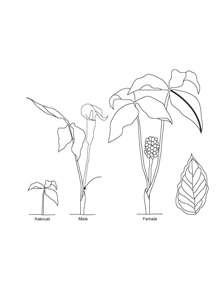ABSTRACTIn this one to two week field project, students investigate the costs of reproduction. In dioecious plants, a female's investment in reproduction is typically much greater than a male's, because while both sexes encounter the basic cost to produce a flower, only females have to allocate energy to seeds, exceeding the energy requirements to produce pollen. This field project tests whether the effects of these unequal costs are reflected in characteristics of individuals of functionally dioecious and long-lived Jack-in-the-pulpit (Arisaema triphyllum) in the field. Students will read two introductory articles and take a pre-project online quiz, collect the data in the field, analyze it, collect and interpret literature sources and will write a short report. AUTHORSIvana Stehlik1 1- Department of Biological Sciences, University of Toronto at Scarborough, 1265 Military Trail, Toronto, ON, Canada, M1C 1A4; ivana.stehlik@utoronto.ca CLASS TIMEOne week or 3 lab hours (in addition to any travel time), if instructor identifies where populations of the study plant are and directs students to them. OUTSIDE OF CLASS TIMESix - seven hours to read two introductory articles and take a pre-project online quiz, analyze the data, collect and interpret literature sources and to write a short report. STUDENT PRODUCTS
SETTINGThis field project is ideally done during the flowering time of Jack-in-the-pulpit (Arisaema triphyllum) which is late spring, but because universities hardly ever schedule classes during this time, I have developed this project to be done starting in summer (after the development of seeds; i.e. during summer (field) ecology courses) into early fall (mid to late September), which makes this lab attractive as an activity for fall courses. Jack-in-the-pulpit is a species common to (moist) deciduous forests in Eastern North America, from Florida to Texas in the south to Nova Scotia, Prince Edward Island to Manitoba (USDA, 2009). It is also easy to recognize and spot based on its characteristic three-parted and fairly large leaves. COURSE CONTEXTThis field activity could be used in two ways: (1) in a third-year ecology course for 12-16 undergraduate students using the instructions as outlined in the present document, where students cooperatively collect their data in groups of two, and (2) in third to fourth year, two-week summer field course setting as an individual student project. In the latter setting, the project approach could be more inquiry-based, as described under Comments on Translating the Activity to Other Institutional Scales or Locations. INSTITUTIONPublic research and undergraduate university of approximately 10,000 students. TRANSFERABILITYThis project would fit general ecology or upper division ecology courses at institutions of all sizes. The lab is simple in design and requires no special technical skills or tools and thus could be transferred to non-majors general biology classes, but access to suitable forested field sites is key. This project could be run using other (perennial) dioecious species, after a careful prior evaluation by the instructor. Jack-in-the-pulpit offers the added twist of potential inter-annual gender changes (as a sequential hermaphrodite), but the basic questions could be tested with any genetically fixed dioecious plant species. DOWNLOADSDescription of other Resource Files:
ACKNOWLEDGMENTSThis field project has a large body of literature backing it up (e.g. Bierzychudek 1982; Doust and Cavers 1982; Policansky 1987; Vitt et al. 2003). As a course unit, I formulated and optimized this field project while teaching a summer field course in experimental ecology and evolution at the University of Toronto, Koffler Scientific Reserve, as a safe and efficient backup project for failing projects due to adverse weather conditions and running out of time to sample. I especially would like to acknowledge the efforts of Katie Krelove who was the first to conduct this field project and smoothed out some of its initial edges. CITATIONIvana Stehlik. 13 July 2011, posting date. Are males cheaper than females? Male and female costs of reproduction Teaching Issues and Experiments in Ecology, Vol. 7: Experiment #2 [online]. http://tiee.esa.org/vol/v7/experiments/stehlik/abstract.html |

Drawings of Jack-in-the-pulpit (Arisaema triphyllum) in the field in late summer to early fall, i.e. when flowering is over. Asexual plants only produce one, typically small leaf (left). Males are typically larger and have a sheath with a lateral hole where previously the male inflorescence (now decayed) was inserted (middle; arrow). Females typically are the largest individuals with typically two leaves and a centrally inserted infructescence with many bright, shiny and red berries (right). Note that some males have two leaves and, in such a case, the hole left behind by the withered inflorescence would be central between the two leaves, such as in the case of females (but obviously with no evidence of an infructescence). The thick line on one of the female leaves depicts how students should measure the length of the largest leaflet of the largest leaf. The single leaflet on the far right demonstrates the characteristic venation of Jack-in-the-pulpit, i.e. with few very conspicuous large veins on either side of the leaf joining some distance of the leaf margin. Drawings: Ivana Stehlik full size image |
<top> | |